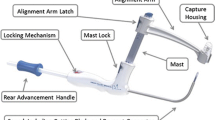Abstract
Background
Antegrade enemas administered through a percutaneously placed Chait Trapdoor™ cecostomy catheter have resulted in a marked improvement in compliance and outcome of patients with fecal incontinence. The percutaneous technique, however, is a two-step procedure that is not performed under direct vision. This report presents the results and lessons learned from our experience with the laparoscopic approach to placement of Chait cecostomy catheters.
Methods
Retrospective review of patients who underwent laparoscopic placement of Chait cecostomy catheters from 1999 to 2008. Data collected included patient demographics, primary diagnosis, hospital stay, complications, follow-up duration and outcome.
Results
Seventeen patients, mean age 11.8 ± 4.2 years (range 5–17), underwent laparoscopic Chait cecostomy catheter placement over a period of 8 years. Median follow-up was 46 ± 21 months (range 4–67). The primary diagnosis was spina bifida in 82% of patients. There was one intraoperative complication, which consisted of tangential needle placement into the cecum, and required conversion to an open procedure. Mean hospital stay was 3.8 ± 1.5 days (range 2–7). Emergency department visits related to Chait catheter complications were mainly due to catheter dislodgement and breakage. Long-term complications included accidental dislodgement of the catheter in seven patients (41%), mechanical failure of the catheter (breaks/leaks) in six patients (35%), hypertrophic granulation tissue in six patients (35%), wound infections at the catheter site in three patients (18%), complications related to the use of fasteners in two patients (12%) and ventirculoperitoneal (VP) shunt infection in two patients (11.8%).
Conclusion
The laparoscopic approach to Chait cecostomy catheter placement is a simple and effective procedure. The rate of long term complications such as catheter dislodgement and mechanical failure, which are responsible for the majority of unplanned ED visits, may be decreased by routine yearly catheter exchanges. VP shunt infections are the most serious complications in this patient population consisting mostly of patients with spina bifida.

Similar content being viewed by others
References
Malone PS, Ransley PG, Kiely EM (1990) Preliminary report: the antegrade continence enema. Lancet 336:1217–1218
Marshall J, Hutson JM, Anticich N, Stanton MP (2001) Antegrade continence enemas in the treatment of slow-transit constipation. J Pediatr Surg 36:1227–1230
Yagmurlu A, Harmon CM, Georgeson KE (2006) Laparoscopic cecostomy button placement for the management of fecal incontinence in children with Hirschsprung’s disease and anorectal anomalies. Surg Endosc 20:624–627
Tantoco JG, Zallen G, Brisseau GF, Glick PL, Caty MG (2003) Miniature access Chait cecostomy; A new approach to the management of fecal incontinence. Pediatr Endosurg Innov Tech 7:327–330
Lemelle JL, Guilleman F, Aubert D, Guys JM, Lottmann H, Lortat-Jacob S et al (2006) A multicentre study of the management of disorders of defecation in patients with spina bifida. Neurogastroenterol Motil 18:123–128
Curry JI, Osborne A, Malone PS (1999) The MACE procedure: experience in the United Kingdom. J Pediatr Surg 34:338–340
Driver CP, Barrow C, Fishwick J, Gough DC, Bianchi A, Disckson AP (1998) The Malone antegrade colonic enema procedure: outcome and lessons of 6 years’ experience. Pediatr Surg Int 13:370–372
Chait PG, Shlomovitz E, Connolly BL, Temple MJ, Restrepo T, Amaral JG et al (2003) Percutaneous cecostomy: updates in technique and patient care. Radiology 227:246–250
Author information
Authors and Affiliations
Corresponding author
Rights and permissions
About this article
Cite this article
Yamout, S.Z., Glick, P.L., Lee, YH. et al. Initial experience with laparoscopic Chait Trapdoor™ cecostomy catheter placement for the management of fecal incontinence in children: outcomes and lessons learned. Pediatr Surg Int 25, 1081–1085 (2009). https://doi.org/10.1007/s00383-009-2496-6
Accepted:
Published:
Issue Date:
DOI: https://doi.org/10.1007/s00383-009-2496-6




